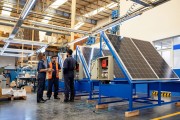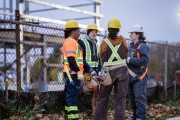The world’s economies are moving full steam ahead on climate action. Seventy countries — including Canada — that account for over 75 per cent of global emissions, have set targets to achieve net-zero by 2050 and limit global warming to 1.5 degrees Celsius. To reach those targets, they are investing in cleaner economies powered by low- or no-carbon sources of energy.
There’s a strong risk that without robust and specific planning workers in many sectors and the communities that support them will be left behind.
Businesses and their investors are also seeing the opportunity the clean energy economy has the potential to create — and the impact the effects of climate change continue to have on their bottom lines — and are making greenhouse gas (GHG) reduction a high priority when it comes to environmental, social and governance (ESG) strategies.
As a result of these global trends, the International Energy Regulator, Canada Energy Regulator and even the oil and gas industry project that global demand for fossil fuels will peak and begin to decline in the next decade, and in Canada, fossil fuel use could drop by up to 65 per cent between 2021 and 2050. In that same timeframe, electricity use could double.
An opportunity for Canada
As the world aligns with a net-zero trajectory, Canada’s traditionally fossil fuel-heavy economy is at a crossroads. Canada has an opportunity to utilize its abundant natural resources, build on our rich history of technology innovation and use its skilled labour force to build a new energy economy. There is much to be gained in investments in clean energy technologies and options like wind and solar power, a robust electric-vehicle supply chain to drive emission reductions. As a result, Canada could see hundreds of thousands of good new jobs generated. But without proper planning, investment and consultation, workers in the energy industry could be left out of this new energy boom.
The federal government has an opportunity to do more for workers and communities impacted by this essential and inevitable transition, to ensure that Canadians are at the forefront of energy planning.
A transition to a clean energy economy, supported by the right investments, plans and policies, could help us realize more economic growth, decent jobs for workers, and pathways for workers in high-emitting sectors to enter good, stable, net-zero jobs with benefits distributed across society.
The Government of Canada is implementing an Interim Sustainable Jobs Plan and has plans to finalize the Sustainable Jobs Act following parliamentary discussion and debate. These landmark moves have the potential to ensure that this energy transition is an equitable one for all Canadians — but the devil is in the details.
The federal government needs to build and operationalize a national framework that brings provincial and territorial governments, industry, workers and communities together, to shape and steer policy and planning decisions and maintain a thriving energy workforce in the near and long term.
A blueprint for sustainable jobs
While the intentions are set, Canada is still in the early stages of building a foundation for what could be a prosperous transition to a clean economy.
The Pembina Institute and the Canadian Labour Congress are working in partnership to develop a comprehensive Sustainable Jobs Blueprint to ensure that energy and workforce planning are happening in lockstep. Four key areas where the federal government must work with provinces and territories, Indigenous nations and municipalities: building the right governance structures, investing in workforce development and regional diversification, and strengthening income security for impacted workers.
 In part one of our Sustainable Jobs series Governance recommendations to support Canada’s clean energy workforce and economy, we provide recommendations on how the federal government can set up the right governance mechanisms, ensuring worker perspectives are at the forefront and investments are aligned with climate commitments and the Canadian Net-Zero Emissions Accountability Act.
In part one of our Sustainable Jobs series Governance recommendations to support Canada’s clean energy workforce and economy, we provide recommendations on how the federal government can set up the right governance mechanisms, ensuring worker perspectives are at the forefront and investments are aligned with climate commitments and the Canadian Net-Zero Emissions Accountability Act.
A prosperous net-zero future will require real commitment from the federal government to work together in good faith with workers and other levels of government.







